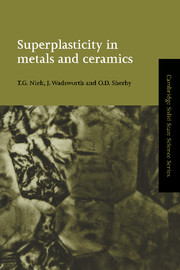Book contents
- Frontmatter
- Contents
- Preface
- Chapter 1 Introduction
- Chapter 2 Key historical contributions
- Chapter 3 Types of superplasticity
- Chapter 4 Mechanisms of high-temperature deformation and phenomenological relations for fine-structure superplasticity
- Chapter 5 Fine-structure superplastic metals
- Chapter 6 Fine-structure superplastic ceramics
- Chapter 7 Fine-structure superplastic intermetallics
- Chapter 8 Fine-structure superplastic composites and laminates
- Chapter 9 High-strain-rate superplasticity
- Chapter 10 Ductility and fracture in superplastic materials
- Chapter 11 Internal-stress superplasticity (ISS)
- Chapter 12 Other possible superplasticity mechanisms
- Chapter 13 Enhanced powder consolidation through superplastic flow
- Chapter 14 Superplastic forming and diffusion bonding
- Chapter 15 Commercial examples of superplastic products
- Index
Chapter 1 - Introduction
Published online by Cambridge University Press: 15 October 2009
- Frontmatter
- Contents
- Preface
- Chapter 1 Introduction
- Chapter 2 Key historical contributions
- Chapter 3 Types of superplasticity
- Chapter 4 Mechanisms of high-temperature deformation and phenomenological relations for fine-structure superplasticity
- Chapter 5 Fine-structure superplastic metals
- Chapter 6 Fine-structure superplastic ceramics
- Chapter 7 Fine-structure superplastic intermetallics
- Chapter 8 Fine-structure superplastic composites and laminates
- Chapter 9 High-strain-rate superplasticity
- Chapter 10 Ductility and fracture in superplastic materials
- Chapter 11 Internal-stress superplasticity (ISS)
- Chapter 12 Other possible superplasticity mechanisms
- Chapter 13 Enhanced powder consolidation through superplastic flow
- Chapter 14 Superplastic forming and diffusion bonding
- Chapter 15 Commercial examples of superplastic products
- Index
Summary
Interest in superplasticity is extremely high. The major areas include superplasticity in metals, ceramics, intermetallics, and composites. Superplasticity at very high strain rates (i.e., approximately 0.1–1 s−1) is an area of strong emphasis that is expected to lead to increased applications of superplastic-forming technology.
Historically, there has been no universally accepted definition for superplasticity. After some debate, the following version was proposed and accepted at the 1991 International Conference on Superplasticity in Advanced Materials (ICSAM-91) held in Osaka, Japan:
Superplasticity is the ability of a polycrystalline material to exhibit, in a generally isotropic manner, very high tensile elongations prior to failure.
It is anticipated that there will continue to be some modifications to this definition, but it should serve as a working definition for a phenomenon that was scientifically reported in 1912 and, indeed, may have a far longer history, as described in the following chapter.
During the course of the ICSAM-91 Conference, many different superplastic materials were described. A list of those mentioned is presented in Table 1.1. It is reasonable to infer from the broad range of superplastic materials listed that there is now a good basic understanding of the requirements for developing superplastic structures.
- Type
- Chapter
- Information
- Superplasticity in Metals and Ceramics , pp. 1 - 4Publisher: Cambridge University PressPrint publication year: 1997
- 5
- Cited by



